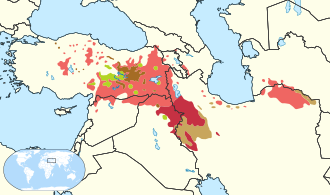Top Qs
Timeline
Chat
Perspective
Kurmanji
Northern Kurdish dialect From Wikipedia, the free encyclopedia
Remove ads
Kurmanji (Kurdish: کورمانجی, romanized: Kurmancî, lit. 'Kurdish', ⓘ),[6][7][8][9] also termed Northern Kurdish,[2][10][11] is the northernmost of the Kurdish languages, spoken predominantly in southeast Turkey, northwest and northeast Iran, northern Iraq, northern Syria and the Caucasus and Khorasan regions.[12] It is the most widely spoken form of Kurdish.
Kurmanji is also the common and ceremonial language of Yazidis.[13] Their sacred book Mishefa Reş and all prayers are written and spoken in Kurmanji.[14]
Ethnologue reports that the use of Kurmanji is declining in Turkey even when the language is used as a language of wider communication (LWC) by immigrants to Turkey, and that the language is threatened because it is losing speakers.[15]
Remove ads
History
Summarize
Perspective
Pre-modern Kurmanji
Although Kurds are mentioned in the pre-Islamic period, there is no information of the Kurdish language before the Islamic period. The first mention of Kurmanji Kurdish is by the medieval Chaldean author Ibn Wahshiyya (d. 930/1) in his treatise about alphabets. Orientalist Joseph Hammer also purported the existence of an alphabet for the language.[16]
Kurmanji may have potentially been a literary language from the 10th to the 12th century with the formation of many Kurdish dynasties such as the Hasanwayhids, Rawadids, Ayyubids and especially under the Marwanids who commanded sizeable economic and cultural prosperity. However, the language of Marwanid administration and culture life was reported to be exclusively Arabic. Under the Ayyubids, many scholars note that Kurmanji gained a privileged status but admit that there is a paucity of evidence due to the lack of written Kurmanji documents from the Ayyubid court.[17]
The first known written attestation of Kurmanji is from the geographical work Mu'jam ul-Buldān by Yaqut al-Hamawi in which few words have been identified in a mostly indecipherable text. The first proper text in Kurmanji is a Christian missionary prayer in the Armenian script from the first half of the 14th century.[18]
A growing interest in the use of Kurmanji in literature began from the 14th century on when Kurdistan had relative political stability and economic prosperity. However, it was not until the 16th century, that a Kurmanji literary tradition arose. During this era, Sharafkhan Bidlisi from the Principality of Bitlis, wrote that a certain leader of the Derzin Castle wrote most of his poetry and theological commentaries in Kurmanji. Furthermore, during his trips to Kurdistan, Evliya Çelebi praised the educational institutions of the Amedi and Akre regions and quoted a Kurmanji poem by local poet in his work. Prominent scholars from this period, whose works are preserved today include Melayê Cizîrî, Feqiyê Teyran, Elî Teremaxî and Ehmedê Xanî. Unlike his peers, Xanî consciously worked to codify Kurmanji as a written language.[19] Pre-modern Kurmanji began to decline in the 19th century simultaneously with decline of the Kurdish principalities.[20]
Remove ads
Phonology
Phonological features in Kurmanji include the distinction between aspirated and unaspirated voiceless stops and the presence of facultative phonemes.[21][22] For example, Kurmanji Kurdish distinguishes between aspirated and unaspirated voiceless stops, which can be aspirated in all positions. Thus /p/ contrasts with /pʰ/, /t/ with /tʰ/, /k/ with /kʰ/, and the affricate /t͡ʃ/ with /t͡ʃʰ/.[22]
Remove ads
Dialect continuum
Summarize
Perspective
Kurmanji forms a dialect continuum of great variability. Loosely, six dialect areas can be distinguished:[23]
- Northwestern Kurmanji, spoken in the Kahramanmaraş (in Kurmanji: Meraş), Malatya (Meletî) and Sivas (Sêwaz) provinces of the northwest of Turkish Kurdistan.
- Southwestern Kurmanji, spoken in the Adıyaman (Semsûr), Gaziantep (Dîlok) and Şanlıurfa (Riha) provinces of Turkish, and Aleppo Governorate, most notably in Afrin (Efrîn), in the west of Syrian Kurdistan.
- Northern Kurmanji or Serhed Kurdish, spoken mainly in the Ağrı (Agirî), Erzurum (Erzerom) and Muş (Mûş) provinces of the northeast of Turkish Kurdistan, as well as adjacent areas.
- Southern Kurmanji, spoken in Al-Hasakah Governorate in the east of Syrian Kurdistan, Sinjar District (Şingal) in the west of Iraqi Kurdistan, and in several adjacent parts of the south of Turkish Kurdistan, centered on the Mardin (Mêrdîn) and Batman (Êlih) provinces.
- Southeastern Kurmanji or Badînî, spoken in Hakkâri Province (Parêzgeha Colêmêrgê) in the southeast of Turkish Kurdistan, and the Dohuk Governorate (Parêzgeha Dihokê) and parts of Erbil Governorate (Parêzgeha Hewlêr) in the north of Iraqi Kurdistan.[24]
- Anatolian Kurmanji is spoken in Central Anatolia (Anatolya Navîn), especially in Konya, Ankara, and Aksaray, by Anatolian Kurds
Ezdîkî and Yazidi politics
Among some Yazidis, the glossonym Ezdîkî is used for Kurmanji to differentiate themselves from Kurds. While Ezdîkî is no different from Kurmanji,[13][25][26][27][28] some attempt to prove that Ezdîkî is an independent language, including claims that it is a Semitic language. This has been criticized as not being based on scientific evidence and lacking scientific consensus.[29]
On January 25, 2002, Armenia ratified the European Charter for Regional or Minority Languages and placed Kurdish under state protection.[30] However, because of the divided Yazidi community in Armenia and after strong criticism from parts of the community, the authorities chose to ratify the charter by mentioning both "Kurdish" and "Yezidi" as two separate languages.[31] This resulted in the term Êzdîkî being used by some researchers when delving into the question of minority languages in Armenia, since most Kurdish-speakers in Armenia are Yazidis.[32] As a consequence of this move, Armenian universities offer language courses in both Kurmanji and Êzdîkî as two different dialects.[33]
Remove ads
Kurmanji among other groups
During the end of the Ottoman era, Assyrians in Tur Abdin shifted from speaking their traditional Turoyo language to either Kurmanji or Arabic.[34] Kurdophone Armenians also exist and there were prior to the Armenian genocide around 110 Kurmanji-speaking Armenian villages in Beşiri and Silvan.[35][36]
Bulgarian,[37] Chechen and Circassian[38] immigrants in Turkish Kurdistan also speak Kurmanji.
Remove ads
See also
- Kurdish alphabets
- Kurdish grammar
- Kurmancî, a Kurdish linguistic magazine
- Mela Huseynê Bateyî
References
Bibliography
Further reading
External links
Wikiwand - on
Seamless Wikipedia browsing. On steroids.
Remove ads


